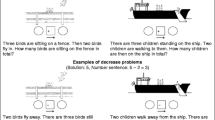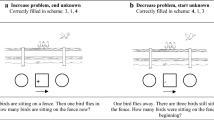Abstract
Forty 6- to 7-year-old children were tested with single-step, addition/subtraction story problems with and without superfluous numerical information. Half of the children were allowed to find out the solution using objects and half were given pen and paper. Fewer problems with superfluous information than those without such information were solved accurately. Less than half of the problems were attempted with spontaneous modelling with objects and rarely were pen and paper used. In many cases, the use of objects could not facilitate solution of problems with superfluous information thus suggesting that in these cases children's failure to solve the problems could not be explained just by an increase in the cognitive demand for selective attention to, and memory of, the relevant information.
Similar content being viewed by others
References
BlankenshipC. S. and LovittT. C.: 1976, ‘Story problems: merely confusing or downright befudding?’, Journal for Research in Mathematics Education 7, 290–298.
Blume, G. W.: 1981, Kindergarten and first-grade children's strategies for solving addition and subtraction problems in abstract and verbal problem contexts, Eric document ED 214 652.
Carpenter, T. P.: 1985, ‘Learning to add and subtract: An exercise in problem solving’, in E. A. Silver (ed.), Teaching and Learning Mathematical Problem Solving, Erlbaum, Hillsdale, N.J.
Carpenter, T. P. and Moser, J. M.: 1982, ‘The development of addition and subtraction problem-solving skills’, in T. P. Carpenter, J. M. Moser and T. A. Romberg (eds.), Addition and Subtraction: A Cognitive Perspective, Erlbaum, Hillsdale, N.J.
CarpenterT. P. and MoserJ. M.: 1984, ‘The acquisition of addition and subtraction concepts in grades one through three’, Journal for Research in Mathematics Education 15, 179–202.
CohenS. A. and StoverG.: 1981, ‘Effects of teaching sixth-grade students to modify format variables of mathematics word problems’, Reading Research Quarterly XVI/2, 175–200.
DeCorteE. and VerschaffelL.: 1987, ‘The effect of semantic structure on first graders' solution strategies of elementary addition and subtraction word problems’, Journal for Research in Mathematical Education 18, 363–381.
GoodsteinH. A., CawleyJ. F., GordonS. and HelfgottJ.: 1971, ‘Verbal problem solving among educable mentally retarded children’, American Journal of Mental Deficiency 76, 208–241.
GoodsteinH. A., BessantH., ThibodeanG., VitelloS. and VlahakosI.: 1972, ‘The effect of three variables on the verbal problem solving of educable mentally handicapped children’, American Journal of Mental Deficiency 76, 703–709.
HebblerK.: 1977, ‘Young children's additon’, Journal of Children's Mathematical Behavior 1, 108–121.
HiebertJ.: 1982, ‘The position of the unknown set and children's solutions of verbal arithmetic problems’, Journal for Research in Mathematics Education 13, 341–349.
HiebertJ.: 1984, ‘Children's mathematics learning: the struggle to link form and understanding’, Elementary Schood Journal 84(5), 497–513.
HughesM.: 1986, Children and Number: Difficulties in Learning Mathematics, Blackwell, Oxford.
IbarraC. G. and LindvallC. M.: 1982, ‘Factors associated with the ability of kindergarten children to solve simple arithmetic story problems’, Journal of Educational Research 75, 149–155.
JermanM.: 1973, ‘Problem length as a structural variable in verbal arithmetic problems’, Educational Studies in Mathematics 5, 109–123.
JermanM. and ReesR.: 1972, ‘Predicting the relative difficulty of verbal arithmetic problems’, Educational Studies in Mathematics 4, 306–323.
KintschW. and GreenoJ. G.: 1985, ‘Understanding and solving word arithmetic problems’, Psychological Review 92, 109–129.
MuthK. D.: 1984, ‘Solving arithmetic word problems: role of reading in computational skills’, Journal of Educational Psychology 76, 205–210.
NesherP.: 1976, ‘Three determinants of difficulty in verbal arithmetic problems’, Educational Studies in Mathematics 7, 369–388.
RileyM. S., GreenoJ. G. and HellerJ. I.: 1983, ‘Development of children's problem-solving ability in arithmetic’ in H. P.Ginsburg (ed.), The Development of Mathematical Thinking, Academic Press, New York.
SherrillJ. M.: 1983, ‘Solving textbook mathematical word problems’, Alberta Journal of Educational Research XXIX, 140–152.
SieglerR. S. and ShragerJ.: 1984, ‘Strategy choices in addition and subtraction: How do children know what to do?’, in C.Sophian (ed.), Origins of Cognitive Skills, LEA, Hillsdale, N.J.
Zweng, M. J.: 1979, Children's Strategies of Solving Verbal Problems, Eric document ED 178 359.
Author information
Authors and Affiliations
Rights and permissions
About this article
Cite this article
Fung Lin, N.L. The effect of superfluous information on children's solution of story arithmetic problems. Educ Stud Math 21, 509–520 (1990). https://doi.org/10.1007/BF00315942
Issue Date:
DOI: https://doi.org/10.1007/BF00315942




